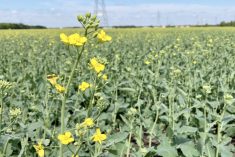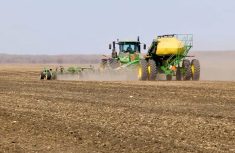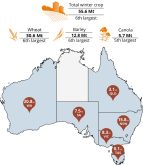For farmers who plan to keep canola in bins through the hottest months of the year, a new Prairie study suggests that to manage bin temperature, less handling is better.
Having set out to study how best to manage higher-moisture canola over the spring and summer, a team from the Prairie Agricultural Machinery Institute (PAMI) has also found that if it goes into the bin cool, dry canola — at moisture below 10 per cent — was at its least risk of spoilage when just left alone.
“Over the course of two separate studies conducted in 2014 and 2016, we found little to no risk of spoilage when canola was just left alone, provided it was cool and dry at the start of spring,” PAMI research scientist Joy Agnew said in a release.
Read Also

Dryness poised to threaten Saskatchewan crops
Crops in Saskatchewan are developing in opposite directions, the province’s latest crop report said. Growing conditions in the province vary, with some areas receiving enough rain while other locations are experiencing crop stress due to hot, dry conditions.
Farmers are becoming more likely to keep canola in bins during the summer months as they take on year-round delivery contracts, bin capacities rise and both canola production and market demand increase, Humboldt, Sask.-based PAMI said in a release Monday.
Stored canola is at greater risk during the spring and summer when warm outside air warms the grain nearest the bin wall, allowing it to pick up free moisture, the PAMI team said.
When that warm, moist air passes through cooler spots in the bin, the moisture can be deposited in the cooler grain, creating a high-moisture zone and posing a higher risk of spoilage.
The PAMI team compared three approaches to managing bin temperature and moisture: leaving it alone, with no handling; aerating the bin; and “turning” the canola, removing it and putting it back to spread out temperature distribution.
The study’s first phase, in 2014, was done to find the best practice for spring and summer storage of canola with relatively higher moisture content. The 2014 findings were revisited in 2016 using canola bins with an average of nine per cent moisture content.
Compared against leaving the bin alone, the PAMI team wrote, “turning the bin resulted in the lowest average bin temperature, while aerating resulted in the most uniform temperature distribution.”
In both cases, though, “turning and aerating helped to equalize the temperature distribution, but resulted in potentially unstable conditions that could increase the risk of spoilage.”
Both turning and aerating can create spots within the bins where cold grain sits directly beside warm grain for short stretches — a problem which “may have resulted in condensation due to the temperature differential.”
Fortunately, the study team said, that didn’t happen in either 2014 or 2016 in this study. When the grain was unloaded, there was “no indication of wet spots or spoilage.”
By comparison, the team wrote, “leaving the grain alone resulted in the most stable and favourable storage conditions.”
The 2016 study results, Agnew noted, helped to broaden the “leave it alone” recommendation to canola with moisture content up to nine per cent, from the previous seven per cent level as monitored in the 2014 study.
Past that, she said, the 2016 results “confirm our observations from our 2014 study.”
Either way, the team cautioned, “monitoring the temperature of canola during storage is recommended, due to the potential for spoilage” over the warmer storage period.
Monitoring, Agnew said, is important “particularly in the spring and summer when temperature differences are most likely to occur… There are many variables that can affect the temperature and moisture in the bins, and producers must monitor the grain conditions on a regular basis.”
The study involved monitoring canola temperature during June, July and August in three 3,500-bushel bins at one location — near Annaheim, Sask., about 140 km east of Saskatoon — using sensors installed inside the bins.
The study team also “intermittently” monitored five other bins with temperature-sensing probes at different nearby sites, to collect data from different initial grain conditions in different sizes of bins. — AGCanada.com Network




















